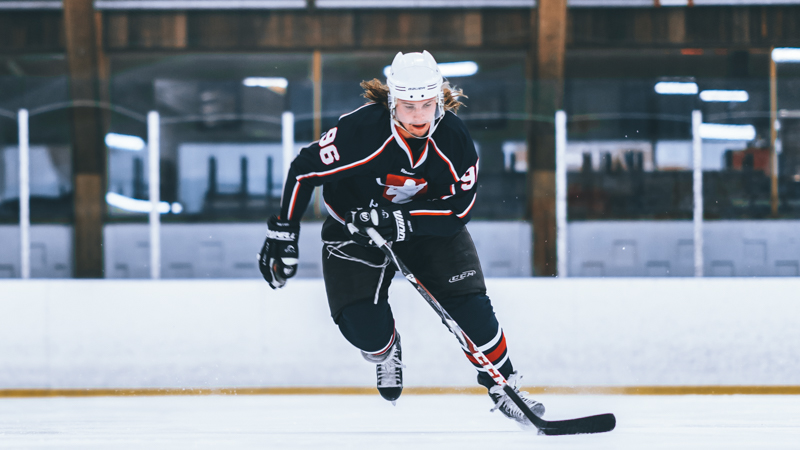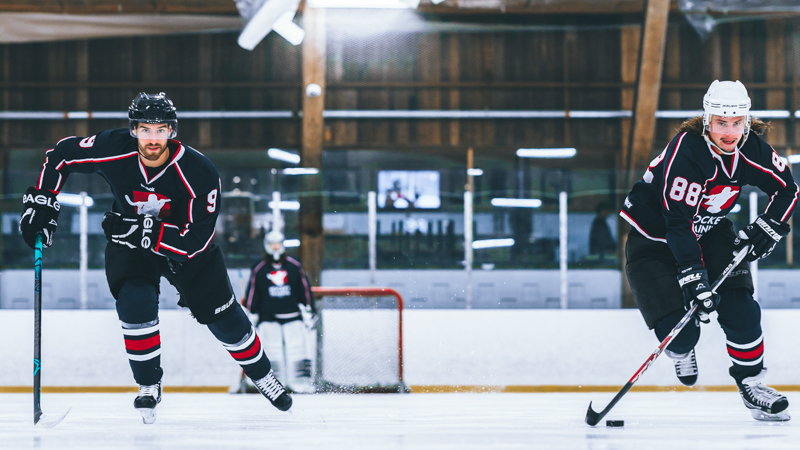In this article, I will break down how strength plays a major role in your speed, agility, and conditioning out on the ice.
I feel the hockey world needs to hear these lessons, because I consistently see and hear of parents and coaches recommending that their kids not perform any strength training, out of fear it will make them slower or less athletic.
This couldn’t be more wrong, and I am confident they would change their minds if they realized the potential they were missing out on.
To avoid confusion, this will be a simple and no-nonsense article aimed to help hockey players who have yet to reach their potential in this sport due to old and outdated training ideas.
Strength vs. Power Development
Strength is very important for hockey players. It makes the difference between an effective player and a benchwarmer, an injury-free player and an injury-plagued player, and a correctly utilized gym membership and a waste of money.
Strength is much more than just your ability to apply force against a barbell: it represents capability and confidence. Strength is your ability to generate force irrespective of the movement produced by doing so. Think about it as your total force production capacity.
However, in the conversation of hockey performance development, when considering any movement that is controlled by muscular force, it is important to also include power production.
Power is force applied to resistance that causes the object providing the resistance to accelerate by increasing the velocity of the movement.
The overhead press, squat, bench press, and deadlift form the basis for any resistance training program that attempts to improve strength.
In the weight room, if the weight on the bar stays the same, the faster the bar moves the more power has been applied to it (same strength output, more power production if you gradually move it faster over time).
If the weight gets lighter, it’s much easier to move faster, so power would depend on how much faster it gets moved (less strength output, more power production).
If you continue decreasing the weight even more, power will eventually go down even though the weight is getting lighter due to the inability of a human to continue to make it faster.
We have natural limitations inherent in the nervous system for maximal speed production, and that’s why the well-established recommendations for peak power production lie within 40–60% of your one-rep max of a given lift.
If you keep going lighter, you will eventually reach your limit velocity. If you continue to go even lighter than that, you will not move any faster but will produce less force due to having a lighter training load.
The same holds true in the opposite direction for different reasons: when you continue increasing the weight to the point where it becomes very heavy for you to lift, power will decrease all the way to zero, yet force production (strength) will be at an all-time high.
In a one-rep max attempt, force is extremely high while power is almost non-existent.
(The sport of powerlifting is very poorly named, since it has nothing to do with power development and has everything to do with simple force production at any rate of velocity.)
Train Slow to Move Fast
Power (which is your ability to accelerate) is arguably the most important ability in hockey. Explosive power can positively translate to everything you do on the ice.
If you have two hockey players with identical skill levels, the more powerful of the two will be the better player, since they are able to utilize their skills more effectively and efficiently.
In sports science literature, the consistently highest power outputs are measured during the second pull of the snatch (which is an Olympic lift, for those who are unfamiliar).
Strength plays an important role in power, since it provides the force involved in the acceleration. Because of this, you can also predict that on a reasonably designed strength training program, strength improvement will lead to power improvement.
However, what most parents and coaches seem to routinely miss is the subtle, indirect role that strength plays during the execution of movements that are most dependent on power expression.
In all expressions of power, whether in the gym or on the ice, there are elements of the movement chain that generate the force that produces the acceleration, and there are elements that transfer the force to the resistance.
For example, when performing a clean (another Olympic lift), the majority of the power development is generated by hip/knee extension and is transferred up the posterior chain and down the arms to the bar.
The efficient transfer of power from the hips/legs to the upper body and into the bar is only possible if the muscles that stabilize the torso are able to hold it in a perfect isometric contraction during the transfer.
Any “give” during that transfer will result in a power leakage, where some power is directed elsewhere and not directly into the bar to complete the lift.
The muscle strength that holds your body stable during high-velocity movement is critical to unlocking your explosive power potential.
The squat, bench press, overhead press, and deadlift all play key roles in your dynamic movement due to their ability to build strength, thus allowing you to absorb and redirect high-velocity force more efficiently.
Furthermore, strength contributes to power, but power doesn’t contribute to strength.
This is why I approach the situation with a “why not do both?” mentality instead of the industry-norm way of looking at things, where the focus is working on cool-looking power drills rather than making sure those are being put to good use by having a well-developed foundation of strength.
Train Slow for More Endurance
Of equal interest to the hockey community is how strength training can impact your on-ice conditioning.
Misleading marketing strategies have managed to convince parents, players, and coaches that weightlifting will make them both slower and less conditioned out on the ice. But the reality is that strength training contributes to conditioning way more than people give it credit for.
Let’s take the example of a hockey player who is able to maintain an average speed of 20km/h on the ice for each shift he plays. (We will take ability out of the equation and just assume he has excellent skating technique.)
This hockey player maintains a 20km/h speed by applying “x” amount of pounds of force into the ice to propel him forward during each skating stride.
Now, we are going to teach him how to squat correctly so we can assess his strength. We identify that his one-rep max is 135 pounds. So his skating force constitutes a percentage of his squatting force: x/135.
After much convincing, his parents have allowed him to do a 10-week strength training program where he effectively increases his squatting strength from 135×1 to 270×1. So this program has doubled his leg strength.
What happens to his endurance out on the ice now that his lower body has become stronger?
Well, it went from x/135 to x/270 in terms of skating stride force production. Put another way, since his force production capacity doubled, it is now 50% easier to generate the same amount of force that allowed him to maintain his 20km/h out on the ice.
He is stronger, so now he doesn’t have to work as hard to maintain the same pace —which in turn, is going to create a dramatic improvement in endurance.
Plus, doubling the force production capacity potential on the ice means that his stride length will also improve.
This analysis applies at some level to every movement on the ice, since hockey demands you perform repeated submaximal contractions.
By lowering the relative intensity of each individual effort (due to getting stronger), the cumulative effort is reduced, so you’ll feel like you have the “fresh legs” you need to go hard all game long.
Of course, some of the numbers I used above were chosen for ease of illustration and explanation, but the same lesson applies regardless.
Strength improvement results in improved functional speed outputs for hockey players, as well as endurance.
Do You Really Think We Should Only Train Slow?
Of course not. Anybody who has undergone the curriculum I designed to become a Certified Hockey Training Specialist understands that we train both slow and fast for the most well-rounded and best results. Anyone who has seen the workouts and programs we create understands that as well.
This article is the simple yet longform answer negating the idea that you can’t squat, bench press, overhead press, or deadlift in a “functional” hockey training program.
These lifts work all the muscles and joints in the body, providing many hockey-specific benefits:
- They simulate normal human movement patterns, which makes them safe to perform, and they produce strength appropriate to all uses for which the muscles and joints will be put out on the ice.
- They can be trained fast or slow with minimal equipment, forming important stabilizing structures for high-velocity movement.
- They affect the body in a systemic way and produce major positive training stress for the body to adapt to.
- They are difficult, thus producing psychological toughness, discipline, and delayed gratification, which are all key psychological qualities for hockey performance development.
And remember, when trained correctly, no hockey player has ever accidentally turned into a bodybuilder overnight and forgotten how to play hockey.
It’s also extremely important to point out that everything I just said above applies to youth hockey players as well—just replace the examples using weightlifting references and instead utilize bodyweight-only exercises (e.g. instead of barbell squats, you would use the example of performing a bodyweight skater squat).
Every youth hockey player following the in-season and off-season training programs here at Hockey Training does resistance training year-round. This helps them become better hockey players in a safe and effective way.
Final Thoughts
I hope this article acts as the figurative “last nail in the coffin” for an idea that should have been dead a long time ago. Strength training doesn’t make you unathletic.
No matter what your age or current ability level is, a properly designed and periodized hockey strength training program will improve your all-around hockey performance.












As Always Coach Dan very well written & to the point !
How do I measure proper weight for my son of 10 years? To improve is insurance in this covid year?
Where thankfully he still able to practice in school. But obviously it’s not to the level of the AA. I willing to try a little program to make it easy for spring hockey – Hopefully are to prepare him for AAA letter pee wii in September.
Thank Coach
Hi Nadia,
At ten years old I don’t recommend measuring any proper weights for your son as he should be training bodyweight-only for the best results.
His own body weight combined with some creative programming will provide PLENTY of resistance for him to improve his game in all areas out on the ice. Check out our free workouts over here to get some great ideas on how you can prepare him for AAA: http://www.hockeytraining.tv